Optimization of the Territorial Spatial Patterns Based on MOP and PLUS Models: A Case Study from Hefei City, China
Abstract
:1. Introduction
2. Materials and Methods
2.1. Study Area
2.2. Data Source
2.3. Methods
2.3.1. MOP Model
2.3.2. PLUS Model
- 1.
- Random Forest Classification for Dual-State Decisions
- 2.
- CA Model Based on Multi-Type Random Patch Seeds
3. Results
3.1. Optimization of the Territorial Spatial Scale
3.1.1. Optimization Schemes
Minimum Carbon Emission
Maximum Carbon Accumulation
Maximum Ecological Benefits
Maximum Economic Benefits
3.1.2. Constraints
3.1.3. Results of Scale Optimization
3.2. Optimization of the Territorial Spatial Layout
3.2.1. Spatial Driving Factors
3.2.2. Accuracy Testing
3.2.3. Results of Simulation Optimization
4. Discussion
5. Conclusions
Author Contributions
Funding
Institutional Review Board Statement
Informed Consent Statement
Data Availability Statement
Acknowledgments
Conflicts of Interest
References
- Cattivelli, V. Planning peri-urban areas at regional level: The experience of Lombardy and Emilia-Romagna (Italy). Land Use Policy 2021, 103, 105282. [Google Scholar] [CrossRef]
- Fox, D.M.; Carrega, P.; Ren, Y.; Caillouet, P.; Bouillon, C.; Robrt, S. How wildfire risk is related to urban planning and Fire Weather Index in SE France (1990–2013). Sci. Total Environ. 2018, 621, 120–129. [Google Scholar] [CrossRef] [PubMed]
- Maleki, J.; Masoumi, Z.; Hakimpourc, F.; Coello, C.A. A spatial land-use planning support system based on game theory. Land Use Policy 2020, 99, 105013. [Google Scholar] [CrossRef]
- Sánchez, M.L.; Cabrera, A.T.; Gómez Del Pulgar, M.L. Guidelines from the heritage field for the integration of landscape and heritage planning: A systematic literature review. Landsc. Urban Plan. 2020, 204, 103931. [Google Scholar] [CrossRef]
- Mukherjee, T.; Sharma, V.; Sharma, L.K.; Thakur, M.; Joshi, B.D.; Sharief, A.; Thapa, A.; Dutta, R.; Dolker, S.; Tripathy, B.; et al. Landscape-level habitat management plan through geometric reserve design for critically endangered Hangul (Cervus hanglu hanglu). Sci. Total Environ. 2021, 777, 146031. [Google Scholar] [CrossRef] [PubMed]
- Lopes, A.S.; Cavalcantea, C.B.; Vale, D.S.; Loureiro, C.F.G. Convergence of planning practices towards LUT integration: Seeking evidences in a developing country. Land Use Policy 2020, 99, 104842. [Google Scholar] [CrossRef]
- Sangawongse, S.; Fisher, R.; Prabudhanitisarn, S. From centralised planning to collaborative urban land use planning: The case of Wat Ket, Chiang Mai, Thailand. Soc. Sci. Humanit. Open 2021, 4, 100154. [Google Scholar] [CrossRef]
- Kaczmarek, I.; Iwaniak, A.; Świetlicka, A.; Piwowarczyk, M.; Nadolny, A. A machine learning approach for integration of spatial development plans based on natural language processing. Sustain. Cities Soc. 2022, 76, 103479. [Google Scholar] [CrossRef]
- Jia, K.J.; He, H.F.; Zhang, H.; Guo, J. Optimization of territorial space pattern based on resources and environment carrying capacity and land suitability assessment. China Land Sci. 2020, 34, 43–51. [Google Scholar]
- Wu, X.T.; Wang, S.; Fu, B.J.; Liu, Y.; Zhu, Y. Land use optimization based on ecosystem service assessment: A case study in the Yanhe watershed. Land Use Policy 2018, 72, 303–312. [Google Scholar] [CrossRef]
- Newland, C.P.; Maier, H.R.; Zecchin, A.C.; Newman, J.P.; van Delden, H. Multi-objective optimisation framework for calibration of Cellular Automata land-use models. Environ. Model. Softw. 2018, 100, 175–200. [Google Scholar] [CrossRef]
- Zhao, H.B.; Wei, J.C.; Sun, D.Q.; Liu, Y.X.; Wang, S.; Tan, J.T.; Miao, C.H. Recognition and spatio-temporal evolution analysis of production-living-ecological spaces based on the random forest model: A case study of Zhengzhou city, China. Geogr. Res. 2021, 40, 945–957. [Google Scholar]
- Ke, X.L.; Xiao, B.Y.; Zheng, W.W.; Ma, Y.C.; Li, Y.H. Urban-agricultural- ecological space zoning based on scenario simulation. J. Geo. Inf. Sci. 2020, 22, 580–591. [Google Scholar]
- Wang, G.Z.; Han, Q.; de Vries, B. The multi-objective spatial optimization of urban land use based on low-carbon city planning. Ecol. Indic. 2021, 125, 107540. [Google Scholar] [CrossRef]
- Akbaria, M.; Neamatollahib, E.; Neamatollahi, P. Evaluating land suitability for spatial planning in arid regions of eastern Iran using fuzzy logic and multi-criteria analysis. Ecol. Indic. 2019, 98, 587–598. [Google Scholar] [CrossRef]
- Feudis, M.D.; Falsone, G.; Gherardi, M.; Speranza, M.; Vianello, G.; Antisari, L.V. GIS-based soil maps as tools to evaluate land capability and suitability in a coastal reclaimed area (Ravenna, northern Italy). Int. Soil Water Conserv. Res. 2021, 9, 167–179. [Google Scholar] [CrossRef]
- Ma, S.H.; Wen, Z.Z. Optimization of land use structure to balance economic benefits and ecosystem services under uncertainties: A case study in Wuhan, China. J. Clean. Prod. 2021, 311, 127537. [Google Scholar] [CrossRef]
- Luo, X.; Lu, X.H.; Jin, G.; Wan, Q.; Zhou, M. Optimization of urban land-use structure in China’s rapidly developing regions with eco-environmental constraints. Phys. Chem. Earth 2019, 110, 8–13. [Google Scholar] [CrossRef]
- Liu, X.P.; Liang, X.; Li, X.; Xu, X.C.; Ou, J.P.; Chen, Y.M.; Li, S.Y.; Wang, S.J.; Pei, F.S. A future land use simulation model (FLUS) for simulating multiple land use scenarios by coupling human and natural effects. Landsc. Urban Plan. 2017, 168, 94–116. [Google Scholar] [CrossRef]
- Liang, X.; Guan, Q.F.; Clarke, K.C.; Liu, S.S.; Wang, B.Y.; Yao, Y. Understanding the drivers of sustainable land expansion using a patch-generating land use simulation (PLUS) model: A case study in Wuhan, China. Comput. Environ. Urban Syst. 2021, 85, 101569. [Google Scholar] [CrossRef]
- Chowdhury, S.; Peddle, D.R.; Wulder, M.A.; Heckbert, S.; Shipman, T.C.; Chao, D.K. Estimation of land-use/land-cover changes associated with energy footprints and other disturbance agents in the Upper Peace Region of Alberta Canada from 1985 to 2015 using Landsat data. Int. J. Appl. Earth Obs. Geoinf. 2021, 94, 102224. [Google Scholar] [CrossRef]
- Li, Y.J.; Ye, C.S.; Huang, X.L. Temporal-spatial evolution and scenario simulation of production-living-ecological space in Nanchang based on CLUE-S model. Res. Soil Water Conserv. 2021, 28, 325–332. [Google Scholar]
- Yu, R.; Huang, X.J.; Xu, G.L. Towards a Theory of Decoupling: The relationship of carbon emission and construction land expansion between 1997 and 2012 in Hefei City, China. Nat. Environ. Pollut. Technol. 2019, 18, 569–577. [Google Scholar]
- Feng, D.R.; Bao, W.K.; Fu, M.C.; Zhang, M.; Sun, Y.Y. Current and future land use characters of a national central city in eco-fragile region—A case study in Xi’an City based on FLUS model. Land 2021, 10, 286. [Google Scholar] [CrossRef]
- Yu, R.; Huang, X.J. Research on the expansion scale of construction land under the restriction of carbon emission peak. China Popul. Resour. Environ. 2019, 29, 66–72. [Google Scholar]
- Golfam, P.; Ashofteh, P.S.; Lo´aiciga, H.A. Modeling adaptation policies to increase the synergies of the water-climate-agriculture nexus under climate change. Environ. Dev. 2021, 37, 100612. [Google Scholar] [CrossRef]
- Yu, R.; Tian, S.M. An analysis of land use and carbon emission in Hefei city based on carrying relationship. J. Anhui Agric. Univ. 2016, 43, 939–945. [Google Scholar]
- Zhao, R.Q.; Huang, X.J.; Zhong, T.Y.; Chuai, X.W. Carbon effect evaluation and low-carbon optimization of regional land use. Trans. Chin. Soc. Agric. Eng. 2013, 29, 220–229. [Google Scholar]
- Xie, G.D.; Zhen, L.; Lu, C.X.; Xiao, Y.; Chen, C. Expert knowledge based valuation method of ecosystem services in China. J. Nat. Resour. 2008, 23, 911–919. [Google Scholar]
- Costanza, R.; d’Arge, R.; de Groot, R.; Farber, S.; Grasso, M.; Hannon, B.; Limburg, K.; Naeem, S.; O’Neill, R.V.; Paruelo, J.; et al. The value of the world’s ecosystem services and natural capital. Nature 1997, 387, 253–260. [Google Scholar] [CrossRef]
- Feng, C.C.; Cao, M.Z.; Xie, T.T. Optimization of land use structure in Tongling city based on different ecological conservation scales. Geogr. Res. 2014, 23, 2217–2227. [Google Scholar]
- Tang, H.J.; Li, M.Z. Study on per capita grain demand based on Chinese reasonable dietary pattern. Sci. Agric. Sin. 2012, 45, 2315–2327. [Google Scholar]
- Ding, M.J.; Chen, Q.; Xin, L.J.; Li, L.H.; Li, X.B. Spatial and temporal variations of multiple cropping index in China based on SPOT-NDVI during 1999–2013. Acta Geogr. Sin. 2015, 70, 1080–1090. [Google Scholar]
- Xu, J.; Gong, P.; Jin, L. Optimization evaluation and analysis on land use structure based on ecological green equivalent in Hohhot. Ecol. Econ. 2019, 35, 196–201. [Google Scholar]
- Dubovyk, O.; Sliuzas, R.; Flacke, J. Spatio-temporal modelling of informal settlement development in Sancaktepe district, Istanbul, Turkey. ISPRS J. Photogramm. Remote Sens. 2011, 66, 235–246. [Google Scholar] [CrossRef]
- Li, X.M.; Zhou, W.Q.; Ouyang, Z.Y. Forty years of urban expansion in Beijing: What is the relative importance of physical, socioeconomic, and neighborhood factors? Appl. Geogr. 2013, 38, 1–10. [Google Scholar] [CrossRef]
- Li, G.D.; Sun, S.A.; Fang, C.L. The varying driving forces of urban expansion in China: Insights from a spatial-temporal analysis. Landsc. Urban Plan. 2018, 174, 63–77. [Google Scholar] [CrossRef]
- Wu, R.; Wang, J.Y.; Zhang, D.C.; Wang, S.J. Identifying different types of urban land use dynamics using Point-of-interest (POI) and Random Forest algorithm: The case of Huizhou, China. Cities 2021, 114, 103202. [Google Scholar] [CrossRef]
- Pontius, R.G.; Boersma, W.; Castella, J.C.; Clarke, K.; de Nijs, T.; Dietzel, C.; Duan, Z.; Fotsing, E.; Goldstein, N.; Kok, K.; et al. Comparing the input, output, and validation maps for several models of land change. Ann. Reg. Sci. 2008, 42, 11–37. [Google Scholar] [CrossRef] [Green Version]
- Wu, Y.; Zong, T.; Shuai, C.Y.; Liao, S.J.; Jiao, L.D.; Shen, L.Y. Does resource environment carrying capacity have a coercive effect on urbanization quality? Evidence from the Yangtze River Economic Belt, China. J. Clean. Prod. 2022, 365, 132612. [Google Scholar] [CrossRef]
- Zhang, Z.; Li, J.M. Spatial suitability and multi-scenarios for land use: Simulation and policy insights from the production-living-ecological perspective. Land Use Policy 2022, 119, 106219. [Google Scholar] [CrossRef]
- Li, Z.J.; Liu, Y.M.; Zeng, H. Application of the MaxEnt model in improving the accuracy of ecological red line identification: A case study of Zhanjiang, China. Ecol. Indic. 2022, 137, 108767. [Google Scholar] [CrossRef]
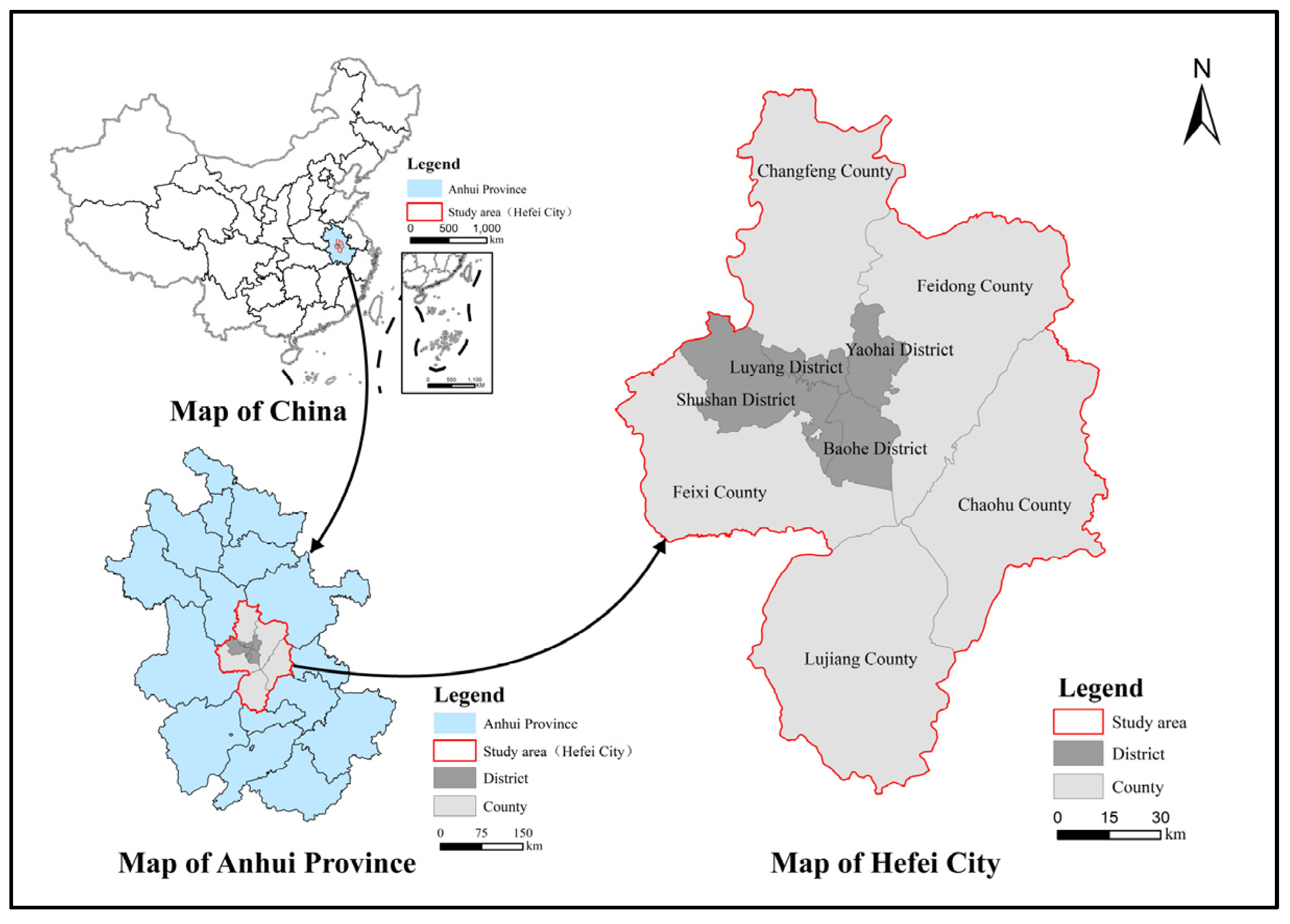
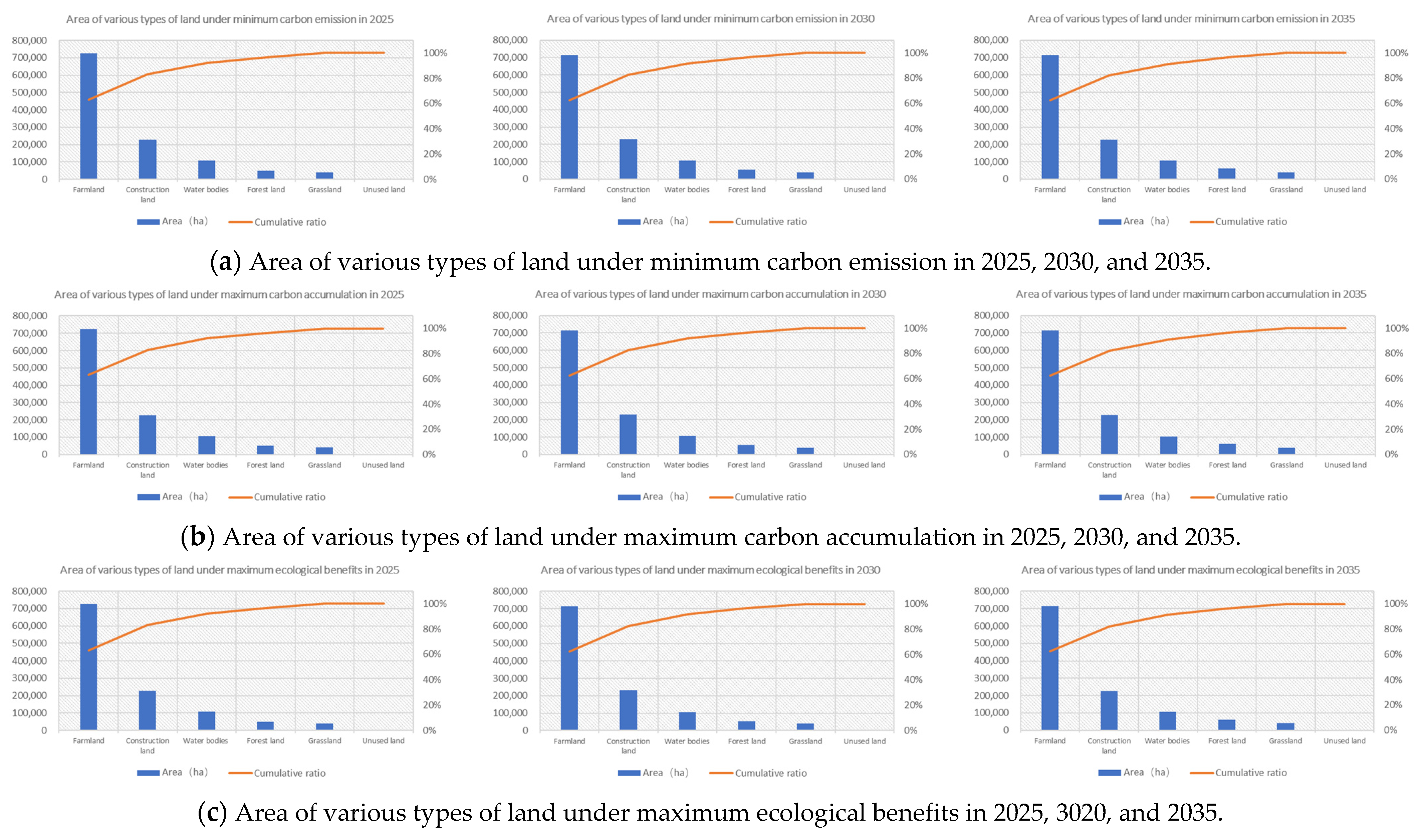

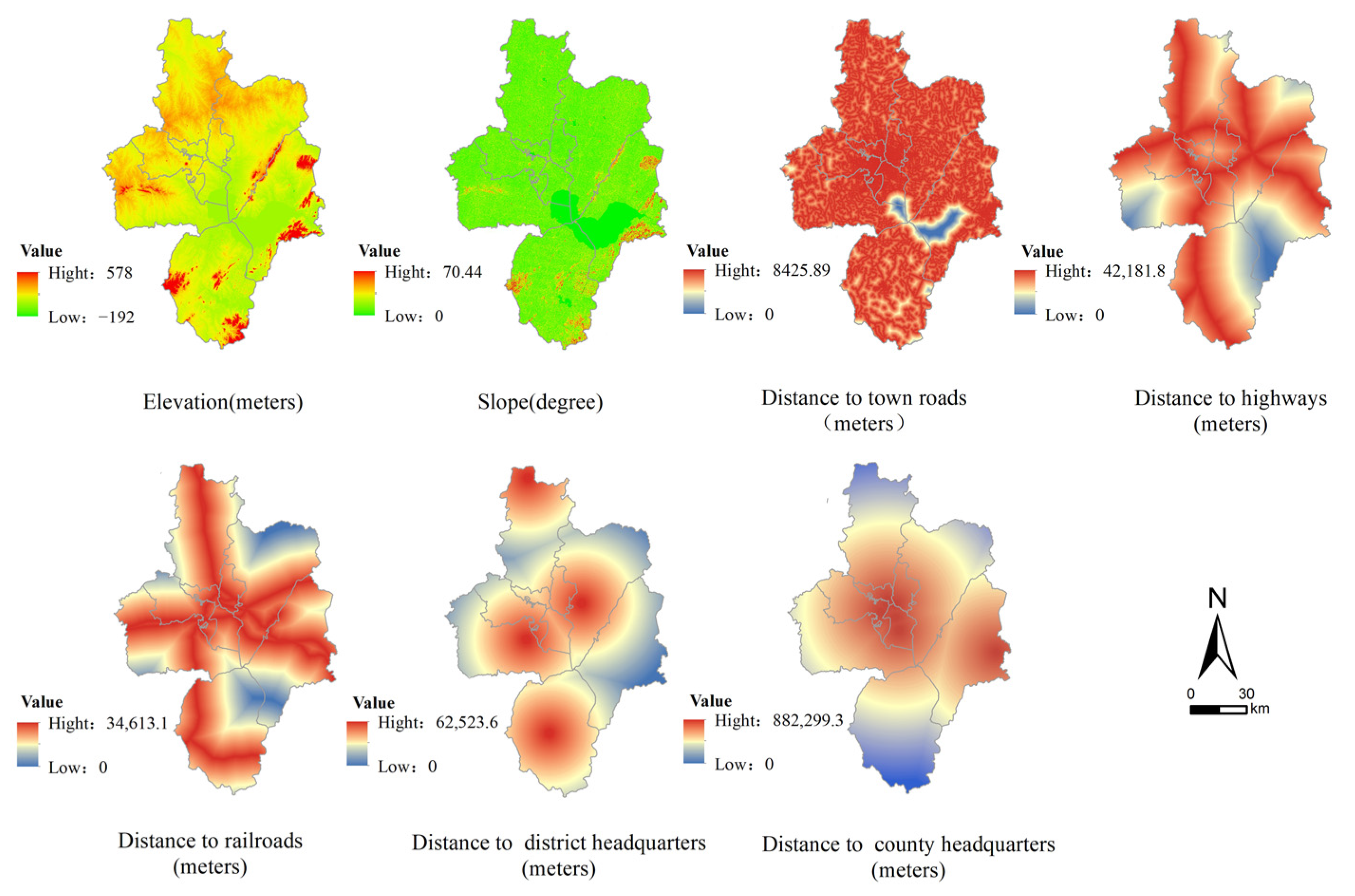
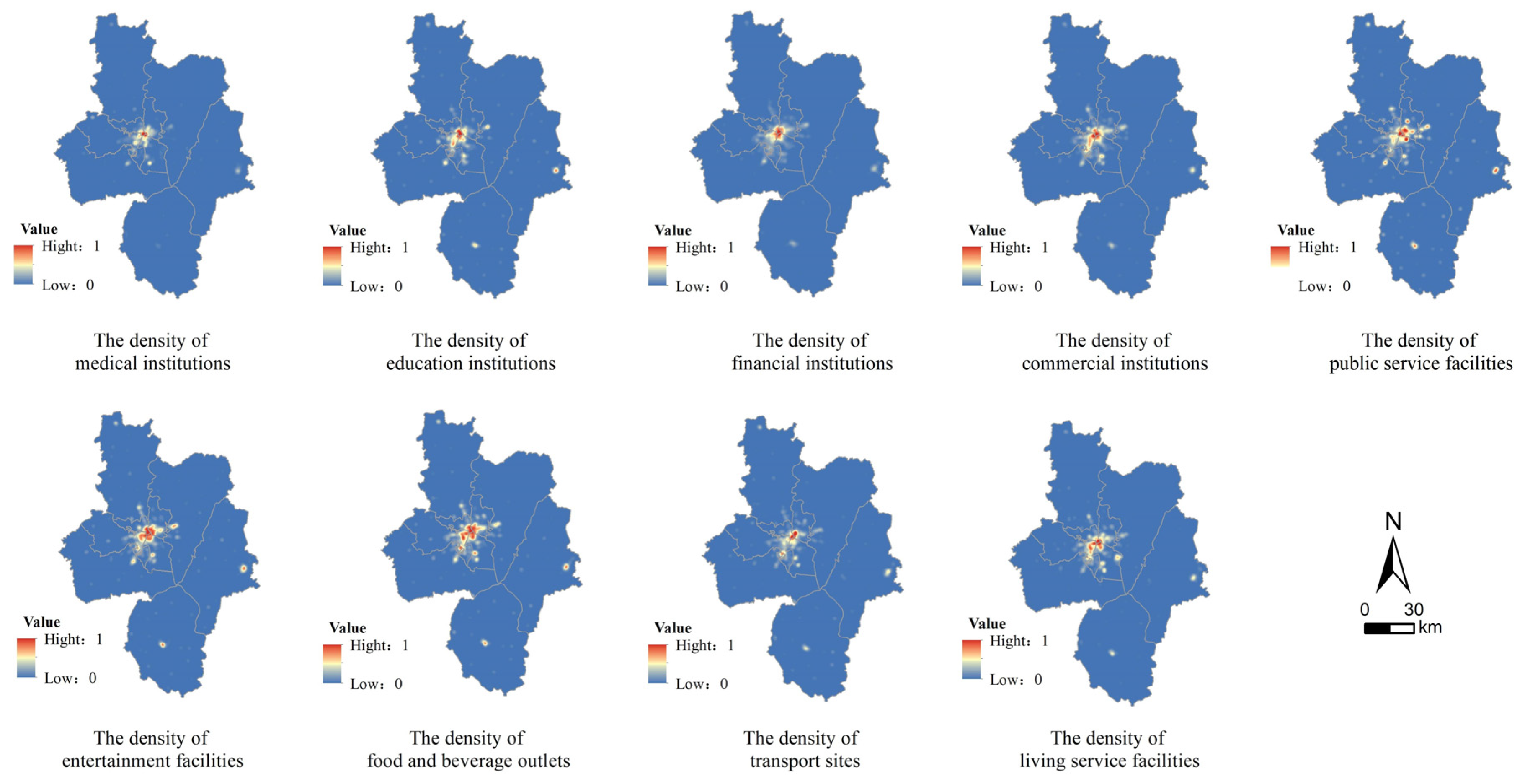
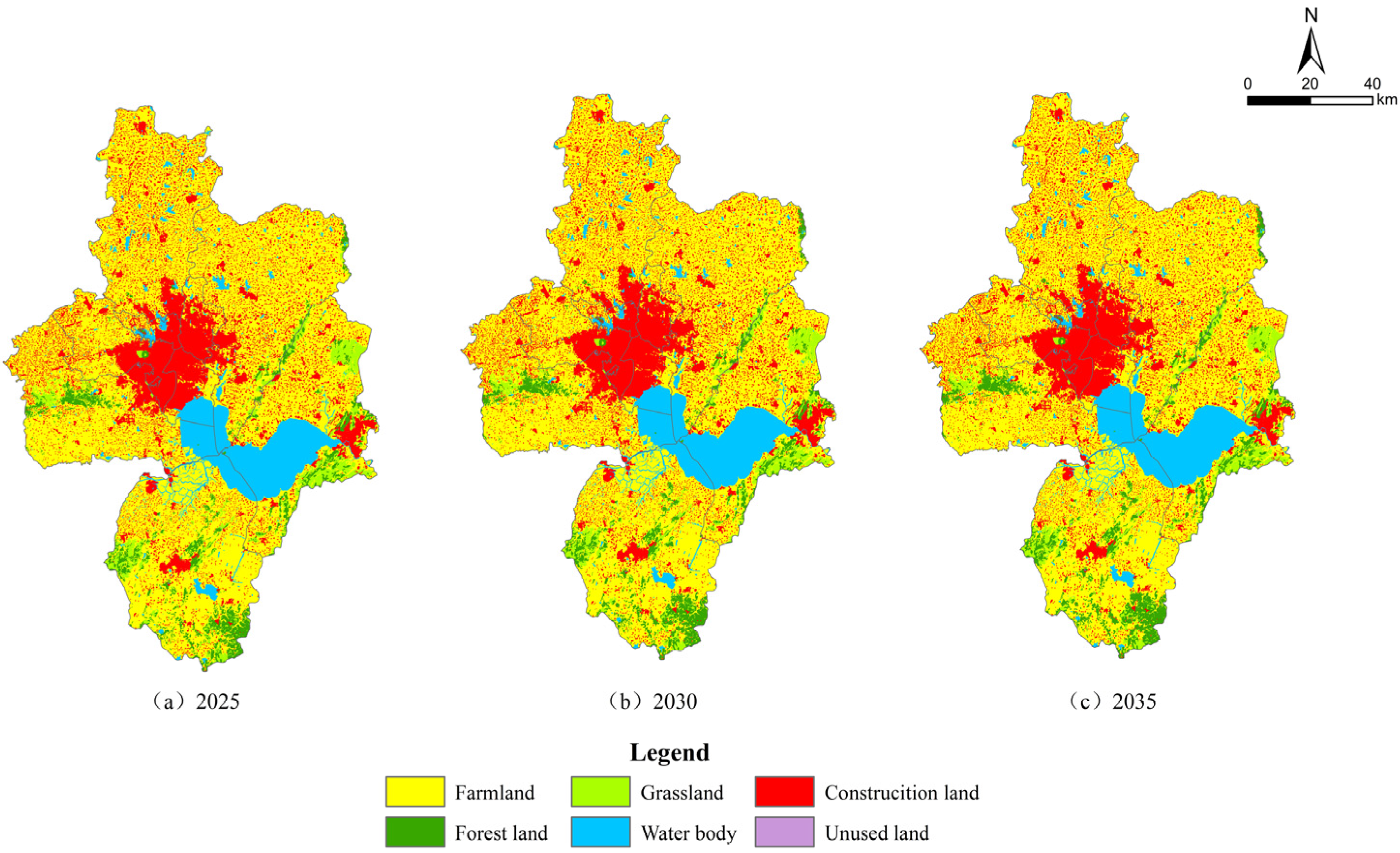
| Target Year | Farmland | Forest Land | Grassland | Water Body | Construction Land | Unused Land | |
|---|---|---|---|---|---|---|---|
| carbon emission coefficient (t/ha) | 2025 | 0.422 | −0.644 | −0.022 | −0.253 | 169.900 | −0.005 |
| 2030 | 333.191 | ||||||
| 2035 | 332.136 | ||||||
| carbon accumulation coefficient (t/ha) | 2025 | 63.015 | 114.331 | 43.965 | 22.690 | 89.436 | 66.973 |
| 2030 | 98.693 | ||||||
| 2035 | 103.198 | ||||||
| ecological benefit coefficient (ten thousand CNY/ha·year) | 2025 | 0.535 | 3.178 | 2.71 | 17.288 | 0.028 | 0.151 |
| 2030 | |||||||
| 2035 | |||||||
| economic benefit coefficient (ten thousand CNY/ha·year) | 2025 | 4.381 | 0.982 | 1.990 | 6.296 | 377.042 | 0.001 |
| 2030 | 7.184 | 2.553 | 11.653 | 1362.647 | |||
| 2035 | 8.695 | 3.823 | 14.869 | 2379.650 |
| 2018 | 2025 | 2030 | 2035 | |
|---|---|---|---|---|
| farmland (ha) | 748,597.50 | 723,702.87 | 714,912.12 | 717,800.85 |
| forest land (ha) | 48,031.65 | 49,539.15 | 54,493.02 | 57,181.50 |
| grassland (ha) | 39,998.70 | 39,593.25 | 39,597.48 | 39,592.62 |
| water bodies (ha) | 105,536.34 | 106,114.32 | 106,021.08 | 106,030.17 |
| construction land (ha) | 204,083.01 | 227,297.70 | 231,223.59 | 225,642.60 |
| unused land (ha) | 24.48 | 24.39 | 24.39 | 23.94 |
| carbon emissions (ten thousand tons) | 3493.11 | 7578.11 | 7728.05 | 7518.24 |
| carbon accumulation (ten thousand tons) | 7507.06 | 7694.08 | 7824.75 | 7920.27 |
| ecological benefits (CNY one hundred million) | 249.18 | 249.29 | 250.23 | 251.24 |
| economic benefits (CNY one hundred million) | 8101.87 | 18,278.64 | 32,166.54 | 54,506.56 |
Disclaimer/Publisher’s Note: The statements, opinions and data contained in all publications are solely those of the individual author(s) and contributor(s) and not of MDPI and/or the editor(s). MDPI and/or the editor(s) disclaim responsibility for any injury to people or property resulting from any ideas, methods, instructions or products referred to in the content. |
© 2023 by the authors. Licensee MDPI, Basel, Switzerland. This article is an open access article distributed under the terms and conditions of the Creative Commons Attribution (CC BY) license (https://creativecommons.org/licenses/by/4.0/).
Share and Cite
Yu, R.; Cheng, H.; Ye, Y.; Wang, Q.; Fan, S.; Li, T.; Wang, C.; Su, Y.; Zhang, X. Optimization of the Territorial Spatial Patterns Based on MOP and PLUS Models: A Case Study from Hefei City, China. Int. J. Environ. Res. Public Health 2023, 20, 1804. https://doi.org/10.3390/ijerph20031804
Yu R, Cheng H, Ye Y, Wang Q, Fan S, Li T, Wang C, Su Y, Zhang X. Optimization of the Territorial Spatial Patterns Based on MOP and PLUS Models: A Case Study from Hefei City, China. International Journal of Environmental Research and Public Health. 2023; 20(3):1804. https://doi.org/10.3390/ijerph20031804
Chicago/Turabian StyleYu, Ran, Hongsheng Cheng, Yun Ye, Qin Wang, Shuping Fan, Tan Li, Cheng Wang, Yue Su, and Xingyu Zhang. 2023. "Optimization of the Territorial Spatial Patterns Based on MOP and PLUS Models: A Case Study from Hefei City, China" International Journal of Environmental Research and Public Health 20, no. 3: 1804. https://doi.org/10.3390/ijerph20031804





